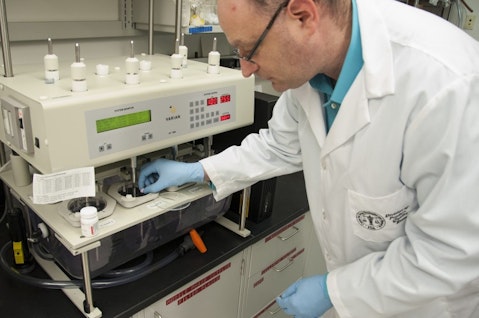Prothena Corporation PLC (NASDAQ:PRTA) just offered up some insight into its ongoing phase I/II in its lead candidate, NEOD001. The trial is one of a host of ongoing studies targeting amyloid light-chain (AL) amyloidosis, each of which is set to serve up major milestones across the next twelve to twenty-four months. Here’s what the latest report tells us about the drug’s performance, and what to look for going forward from a catalyst perspective.
So, first, let’s get a look at the science. AL amyloidosis is the most common form of what’s called systemic amyloidosis. In healthy individuals, when our body breaks down proteins, the fragments of protein that remain are – in turn – broken down and expelled from the body through the various standard means. These fragments are called amyloids. In people that have amyloidosis, their bodies don’t break don’t the amyloids, and they fold up abnormally and then build up in various parts of the body – specifically organs. AL amyloidosis occurs when the the protein fibers that build up are composed of what are called amyloid light chains; essentially chains of antibody producing cells. Kidneys are traditionally the most affected organ that is sensitive to AL build up, but they are far from alone. Heart, lungs and skin are all prime AL targets, and this means the condition presents a full spectrum of symptoms and – as such – is not that easy to diagnose early stage; not because there aren’t tests available, but because recognizing the symptoms as those of ALA isn’t always easy.
The MOA of NEOD001 is relatively straightforward. It’s a monoclonal antibody that targets the AL amyloids, and breaks them down so that they can be processed and removed normally, as opposed to building up.

There are three primary ongoing trials. The first, a phase III global study called VITAL. This one targets patients with ALA that are showing signs of cardiac dysfunction as a result of the condition. Enrollment isn’t set to complete in the VITAL trial before the end of Q2 next year, but we should see some interim data before then. Why? It’s a 28 day dosing in treatment naïve patients, so feedback should be required on patient status as each patient reaches his or her dosing maturity. With any luck, Prothena will relay this feedback and we will have something to go on ahead of topline.
The second trial is called PRONTO. It’s a phase IIb, and it’s also targeting patients that have cardiac dysfunction as a symptom, but in this one the candidates have already been treated with what’s called a plasma cell directed therapy; a treatment designed to target symptoms that is pretty much the only SOC available and doesn’t cure the condition. Many patients are no responsive, and these are the ones that qualify for PRONTO. Again, we’ve got to wait until next year for topline from this one. Late 2017, early 2018 is the target report period, but just as with VITAL, we’d expect some interim analysis based on the dosing schedule.
Finally, the phase I/II we introduced at the beginning of this piece. This is the near term catalyst, with the data just having become available. Patients with three separate types of symptoms (kidney, cardiac and peripheral nervous system) took gradually escalating doses of the drug to find the maximum tolerable dose, and then a number from each (the best responders) carried through into an extension. As per the latest data, the peripheral nervous system arm of the trial showed an 82% response rate, as defined by a decline in what’s called NIS-LL, which is a sort of baseline measure of peripheral NS pain, to the tune of 35% across the responders. For those not familiar with this space, and to offer up a bit of context, that’s a great bit of data.
Cardiac and renal patients all showed a strong response, with 47% of the expansion cohort in the cardiac study showing a more than 30% decrease in NT-proBNP, which is a surrogate marker used for amyloid buildup; and 63% of the expansion cohort in the renal study showing a more than 30% decrease in proteinuria, which is the abnormal levels of protein in the urine associated with AMA. Again, these are some pretty strong results.
So what are we looking at going forward? Well, we should see some detailed topline cross the next eight weeks or so from this phase I/II, and this will offer a little more insight into the exact three-cohort breakdown for things like safety, pharmacokinetics, etc. This will likely serve up some volatility in Prothena’s valuation near term. Beyond that, interim from the two late stage, above mentioned trials, and then topline from each. One to keep an eye on.
Follow Prothena Corp Public Ltd Co (NASDAQ:PRTA)
Follow Prothena Corp Public Ltd Co (NASDAQ:PRTA)
Receive real-time insider trading and news alerts
Note: This article is written by Roger Hannington and originally published at Market Exclusive.


